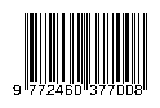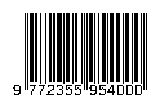Marketing; Past, Present and Future
Abstract
Full Text:
PDF (Bahasa Indonesia)References
Bartels, Robert. (1962). The Development of Marketing Thought. Homewood, IL: Richard D. Irwin. Bauer, P. T. dan B. S. Yamey. (1954). The Economics of Marketing Reform. Journal of Political Economy, Vol. 62, No. 3. pp. 210-235. Biggadike, E. Ralph. (1981). The Contributions of Marketing to Strategic Management. The Academy of Management Review, Vol. 6, No. 4. pp. 621-632. Camino, Jaime Rivera. (2007). Re-evaluating Green Marketing Strategy: A Stakeholder Perspective. European Journal of Marketing Vol. 41 No. 11/12, pp. 1328-1358. DOI 10.1108/03090560710821206. Cavallo, Marino dan Piergiorgio Degli Esposti. (2012). Handbook of Green Communication and Marketing. Project Cofinanced by the European Regional Development Fund (ERDF). ISBN 978-88-568-4937-0. Cronin, J. Joseph, Jr., Jeffery S. Smith, Mark R. Gleim, Edward Ramirez dan Jennifer Dawn Martinez. (2010). Green Marketing Strategies: An Examination Of Stakeholders And The Opportunities They Present. J. of the Acad. Mark. Sci. DOI 10.1007/s11747-010-0227-0. Day, George S. dan David B. Montgomery. (1999). Charting New Directions for Marketing. Journal of Marketing, 63 (Special Issue). pp. 3–13.
Davidoff, John. (2007). Reaching New Markets: The Power of Partnership Marketing. Versi online : http://www.davidoffcommunications.com/filebin/John%20Davidoff%20-%20PMA%20-%20Partnership%20Marketing%20011107.pdf. Glade, William P. dan Jon G. Udell. (1968). The Marketing Concept and Economic Development: Peru. Journal of Inter-American Studies, Vol. 10, No. 4. pp. 533-546. Griffin, C. E., Melvin T. Copeland, F. E. Clark, Edward A. Filene, Theodore N. Beckman, Harry R. Tosdal dan Carl N. Schmalz. (1928). Marketing. The American Economic Review, Vol. 18, No. 1, Supplement, Papers and Proceedings of the Fortieth Annual Meeting of the American Economic Associatio. pp. 17-28.
Harrell, G.D. dan Frazier, G.L. (1999). Marketing: Connecting with Customers. Upper Saddle
River, New Jersey: Prentice Hall. Holbrook, Morris. (1999). Introduction to Consumer Value: A Framework for Analysis and Research, Morris B. Holbrook, ed. London: Routledge.
Kahn, Kenneth B. and Matthew B. Myers. (2001). Framing Marketing Effectiveness As A Process And Outcome. www.sagepublications.com. Volume 5(4): 457–469. DOI: 10.1177/1470593105058825.
Versi Online; http://mtq.sagepub.com/cgi/content/abstract/5/4/457. Lehmann, Donald R. (2005). Journal Evolution and the Development of Marketing. Journal of Public Policy & Marketing. Vol. 24 (1). pp. 137–142. Lusch, Robert F. (2007). Marketing’s Evolving Identity: Defining Our Future. American Marketing Association. Vol. 26 (2). pp. 261–268. Lyon, Leverett S., Edwin R. A. Seligman, Herbert P. Sheets, John G. Lonsdale,Harry R. Tosdal, Paul D. Converse dan C. C. Hanch. (1927). Marketing. The American Economic Review, Vol. 17, No. 1, Supplement, Papers and Proceedingsof the Thirty-ninth Annual Meeting of the American Economic Association. pp. 48–61. Kirkpatrick, Jerry. (1983). The Contributions of Marketing to Strategic Management. The Academy of Management Review, Vol. 6, No. 4. pp. 621-632. Kotler, Philip. (2002). Marketing Management Millenium Edition. Tenth Edition, Prentice-Hall, Inc. A Pearson Education Company Upper Saddle River, New Jersey. Maxim, Andrei. (2009). Relationship Marketing – A New Paradigm In Marketing Theory And Practice. ANALELE Stiinłifice ALE Universităłii „ALEXANDRU IOAN CUZA” DIN IASI Tomul LVI StiinŃe Economice. McKitterick. J. B. (1956). The Need for Basic Research in Marketing. Operations Research, Vol. 4, No. 4. pp. 460-467. Nanda, Rahul dan Parul Khanna. (2011). A Historical Overview Of Marketing Strategies. International Journal of Multidisciplinary Research Vol.1 Issue 7. Nandini dan M. Deshpande. (2011). A Conceptual Framework on Green Marketing – A Tool For Sustainable Development. International Journal of Sales and Marketing Management. Vol. 1. Issue 1. Pp. 1 – 16. Palmatier, Robert W. (2008). Relationship Marketing. Marketing Science Institute, 1000 Massachusetts Ave., Cambridge, MA. Peattie, Ken dan Andrew Crane. (2005). Green Marketing: Legend, Myth, Farce Or Prophesy?, Qualitative Market Research: An International Journal Vol. 8 No. 4, pp. 357-370. DOI 10.1108/13522750510619733.
Polonsky, Michael Jay. (1994). An Introduction To Green Marketing. Electronic Green Journal, 1(2). UCLA Library, UC Los Angeles. Versi online: http://escholarship.org/uc/item/49n325b7.
Richarme, Michael. (2005). Consumer Decision-Making Models, Strategies, and Theories, Oh My!.Versi online; http://www.decisionanalyst.com/Downloads/ConsumerDecisionMaking.pdf. Sarkar, Anirban. (2012). Green Marketing And Sustainable Development Challenges And Opportunities. International Journal of Marketing, Financial Services & Management Research. Vol.1 Issue 9. Sheth, Jagdish N. (1967). A Review of Buyer Behavior. Management Science, Vol. 13, No. 12, Series B, Managerial. pp. B718-B756. Sheth, Jagdish N. dan Atul Parvatiyar. (1995). The Evolution of Relationship Marketing. International Business Review, Vol. 4, No. 4, pp. 397-418.
DOI: https://doi.org/10.21107/jsmb.v1i1.1510
Refbacks
- There are currently no refbacks.
Copyright (c) 2016 Mohammad Arief

This work is licensed under a Creative Commons Attribution 4.0 International License.

Jurnal Studi Manajemen dan Bisnis by Universitas Trunojoyo Madura is licensed under a Creative Commons Attribution 4.0 International License.








